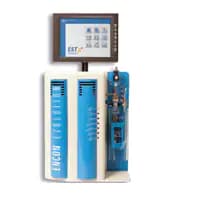Environmental Solutions
Shimadzu Gas Chromatography
Gas Chromatography uses a column to separate compounds from each other and measure them. Gas chromatography separates analytes when they are in the gaseous phase. Most environmental methods extract samples into an organic solvent and then concentrated to a small volume.
A gas chromatograph consists of an injector, the separation column, and a detector. The column separates the components of a mixture and the retention time identifies each component. The intensity of the peak is proportional to its concentration. All chromatography methods rely on separation by time and then detection of the peaks. Different types of detectors can be used depending on what you are trying to measure.
The method determines the detector you will need. Since many GC methods require two-column confirmation, you may need two identical detectors. For a small sample load, you can get one detector and move the column. For less hassle and larger sample loads, get two detectors, two columns, and two injectors.

Use a flame ionization detector and a purge and trap to analyze samples for gasoline range organics (GRO) by Method 8015. Couple with a photoionization detector (PID) and measure BTEX / GRO by methods 8020 and 8015, respectively.
For organochlorine pesticides, chlorophenoxy herbicides and/or haloacetic acids use a dual column instrument with two injectors and two Electron Capture Detectors (ECD).
For organonitrogen and/or organophosphorus pesticides use a dual column instrument with two thermoionic detectors (TID), or a thermoionic detector and a flame photometric detector (FPD). For greater sensitivity, but requiring extra sample preparation, use an ECD.
Other Solutions
- Atomic Absorption
- Balances
- Energy Dispersive XRF
- Gas Chromatography
- GCMS
- Gas Chromatography Tandem Mass Spectrometry
- HPLC
- ICP/AES
- ICP/MS
- Ion Chromatography
- LCMS
- MALDI iD-Plus
- On-Line Analyzers
- Spectrophotometers
- Total Nitrogen Analyzers
- Total Organic Carbon Analyzers (TOC)
- Return to Environmental Top Page


